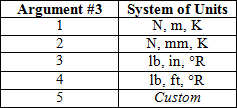Appendix A.3 - Argument #3: System of Units
All numerical quantities in a finite element method input file must be expressed in a consistent set of units. For example, if the geometry of the model is specified in centimeters and the force is specified in Newtons, the material moduli must be expressed in units of N/cm2.
All material properties in the Helius PFA composite material database are stored using the N,m,K system of units (i.e., force is expressed in Newtons; length is expressed in meters, and temperature is expressed in degrees Kelvin). Therefore, if a model is built using a different system of units, you must identify the appropriate system of units the software should use in providing constitutive information to the ANSYS finite element code. Helius PFA has pre-programmed conversion factors that can be used to express constitutive information in several commonly used systems of units. In addition, it has the capability to provide constitutive information in a user-defined (or custom) system of units.
The system of units used by the Helius PFA user programmable feature is defined by the 3rd argument listed as part of the HELIUS command. The table below shows the allowable range of integer values for the 3rd argument and lists the system of units specified by each value.

If the third argument is assigned a value of 1, 2, 3, or 4, Helius PFA will automatically perform the appropriate unit conversions and provide the constitutive relations in the system of units shown in the table above. However, if the model is defined using a system of units that is not represented in the table, you must set the value of the first argument to 5, indicating that a 'custom' system of units will be used. In this case, you must specify the three conversion factors needed to convert from the default units of Newtons, meters, and Kelvin to the custom system of units. These three conversion factors for force, length, and temperature will be listed in the HIN file as discussed earlier (The HIN File).